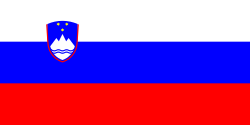| Slovenia at the 2015 Summer Universiade | |
|---|---|
 | |
| IOC code | SLO |
| NOC | Slovenian Olympic Committee |
| Website | http://www.olympic.si/index.php?id=275 |
| in Gwangju, South Korea 3 – 14 July 2015 | |
| Competitors | 45 in 9 sports |
| Medals Ranked 50th |
|
| Summer Universiade appearances | |
Slovenia participated at the 2015 Summer Universiade in Gwangju, South Korea.